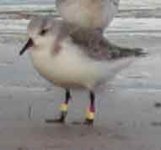Just an update as regards the Sanderling I contacted the site that Colin gives above and received this email this morning - looks like I was a bit out in the ageing - should be 1979 !
Dear Nicholas,
Many thanks for reporting your Sanderling colour-ring sighting. Though our work at Durham University has had to end, we are still interested in receiving colour-ring sightings to subsequently feed into the national ringing database. From the photo kindly provided, the red ring appears to be over the yellow with no rings above either knee. This makes the bird an individual ringed at Teesmouth on 28th May 1979 as first summer, i.e. born in summer 1978.
For your information, I've copied below text from a report I'm working on that details some of the findings we have had from colour-ringing of Sanderling at Teesmouth.
Many thanks again for the colour-ring sighting,
Best regards,
Robin
4.1.1 Sanderling
Sanderling from breeding populations in arctic Canada, Greenland, Svalbard and Siberia occur in Britain. Some birds only pass through in spring and autumn, and go on to winter in South Africa. Others undertake post-nuptial moult and over-winter (Smit & Piersma 1989). The proportion of the passage and wintering populations in Britain that originate from the different breeding areas is currently unknown (Davidson et al 1986, Smit & Piersma 1989).
Adult Sanderling begin arriving at Teesmouth from mid July from Nearctic breeding grounds as suggested from several spring Icelandic recoveries. Some birds undertake post-nuptial moult whilst others pass rapidly through to wintering areas that extend south to Ghana. From late October birds, that have moulted on the Wash arrive at Teesmouth to winter along the northeast coast. Whether most/all these latter birds originate from Nearctic breeding grounds is unknown. Juveniles begin arriving by September, Icelandic spring recoveries suggesting these birds to be from the Nearctic population. For this later cohort, colour ring sightings have demonstrated that many winter and most moult at Teesmouth in subsequent years. Autumn recoveries of birds from Poland, Sweden (Ottenby & Kalmar) and Germany (Rostock) ringed in previous autumns or winters at Teesmouth, may be Nearctic birds (Gudmundsson & Lindstrom 1992). No data as yet indicate any of Teesmouth's Sanderling to be confirmed Siberian birds i.e. located at or near the breeding grounds or within the proposed spring route of a loop migration (Nikolaus & Chernitchko unpubl.).
The increase in the Teesmouth population during mid-winter, is partly the result of the arrival, of birds from the adjacent coastline These birds later re-disperse prior to their return for prenuptial moult (Cooper 1987). Colour ring sightings at Teesmouth indicate high site fidelity of Sanderling for wintering and moulting sites (Cooper 1987). However two recoveries suggest that some juveniles may be on the Wash in their first winter, and are present at Teesmouth in a subsequent winter having undertaken post-nuptial moult at the Wash.
Most birds depart from Teesmouth for the breeding grounds during spring after pre-nuptial moult. Eight colour-ringed birds present either in autumn or winter at Teesmouth have been subsequently sighted in spring on the German and Danish Wadden Sea coasts (5 & 2 recoveries respectively), and the Netherlands (1); these are almost certainly Nearctic breeders (Klaus Günter pers. comm.). Birds that have wintered south of Britain, pass through Teesmouth in spring, with numbers often peaking in late May. Two recoveries from these passage birds show some may move along the west coast in another spring or autumn. Both passage and wintering populations at Teesmouth provide the 48 spring recoveries of presumed Nearctic breeders staging in southwest Iceland (Gudmundsson & Lindstrom 1992). Amongst these birds are several within season recoveries, and an individual also sighted in different autumns in Schleswig-Holstein, Germany and France.
Whereas Teesmouth supports nationally important numbers of Sanderling throughout the non-breeding season, it is only during autumn and in particular spring passage that Seal Sands is frequented by the species and in large numbers at low tide; winter residents are also present. The broad range within weekly low tide counts during passage periods is both a reflection of turnover rates and variable site usage between years. Recent observations elsewhere along North Sea coasts show the use of mudflats during passage periods for a species more typical of open sea beaches and rocky scars, to occur.
R.M.Ward (working draft, EN report, 27/1/03)
----------------------------------------------------------------------------------------
Robin M. Ward,
Waterbird Monitoring Officer,
The Wildfowl & Wetlands Trust,
Slimbridge, Glos. GL2 7BT, U.K..
Tel no. 01453 891900 ext 272
Fax no. 01453 890901
e-mail:
[email protected]
Website:
http://www.wwt.org.uk




